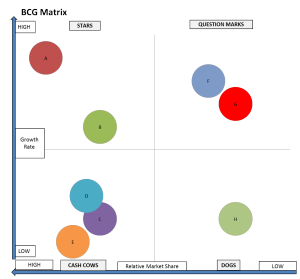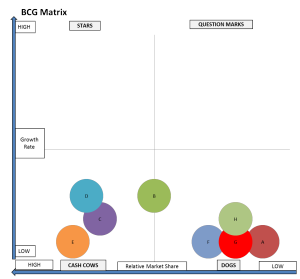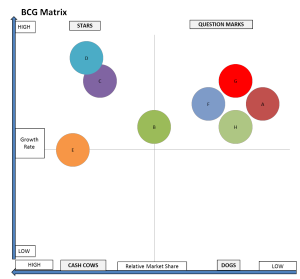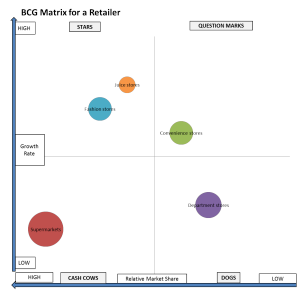Contents
Using the BCG matrix for portfolio analysis
One of the prime uses of the BCG matrix is for portfolio analysis – that is, to ensure that the overall company has an appropriate mix of business units and/or product in its overall portfolio.
In this article on the BCG matrix and portfolio analysis, both good and poor portfolios will be presented and quickly discussed.

The ideal BCG matrix portfolio
Ideally, a well proportioned portfolio would have a diversity of offerings across the four quadrants, with a heavier weighting towards cash cows and stars, and a lower number of dogs and question marks.
As we know, the best quadrant for profitability today is the cash cow quadrant and the best quality quadrant for profitability in the future is the star quadrant – so portfolios that have higher proportions of cash cows and stars are preferred.
This first diagram is a good example of the ideal BCG matrix portfolio – as you can see there are several cash cows and two well-placed stars to ensure profitability into the future. There are a couple of dogs and question marks, which indicates that the firm is relatively proactive in the marketplace and is trying to look for opportunities.
A conservative BCG matrix portfolio

In this next BCG matrix example, the firm in question only has cash cows and dogs. This would represent the business portfolio of a very conservative organization.
There is no doubt that his organization would be extremely profitable, as none of its portfolios would require any significant reinvestment – as they are all in mature and stable markets.
However, the significant concern here is the lack of investment in the future. The firm has no portfolios placed into growth markets. This demonstrates a clear lack of initiative and innovation on behalf of the company.
They are clearly pursuing a short-term strategy and 5 to 10 years down the track, as their cash cows and dogs potentially enter the decline stage of the product life-cycle, they will have limited opportunities to replace that income. In other words, this is a very shortsighted strategic approach.
A poor BCG matrix portfolio

This next example of a BCG matrix portfolio is significant concern.This particular firm has no cash cows – which means that they have no portfolios capable of generating sufficient income that can be reallocated to the stars and question marks as required.
Of major concern here is the high proportion of question marks – which are all heavy users of cash. It could be possible for the stars to become self-supporting, but they will not have surplus income to assist the question marks.
Therefore, this is probably an example of a start-up company that has invested into too many areas and would be burning a lot of cash. The logical recommendation for this firm would be to divest most of its question marks and try to manage the cash flow of its stars until one or two of them become cash cows.
A nice and balanced BCG portfolio
 This final example is discussed in more detail in the example section for a retailer on this website. This BCG matrix portfolio is probably represents a typical real-life firm.
This final example is discussed in more detail in the example section for a retailer on this website. This BCG matrix portfolio is probably represents a typical real-life firm.
You will note that they have one significant cash cow, which would provide surplus income to be reinvested in other parts of the business.
You should also note that they only have one question mark, with a couple stars coming through. And they would probably be looking to divest the department store dog or to simply run it as a cash dog for the foreseeable future.
This would be considered to be a nicely balanced BCG matrix portfolio because they have only a few, but valuable, portfolios and there is a weighting towards cash cows and stars.
